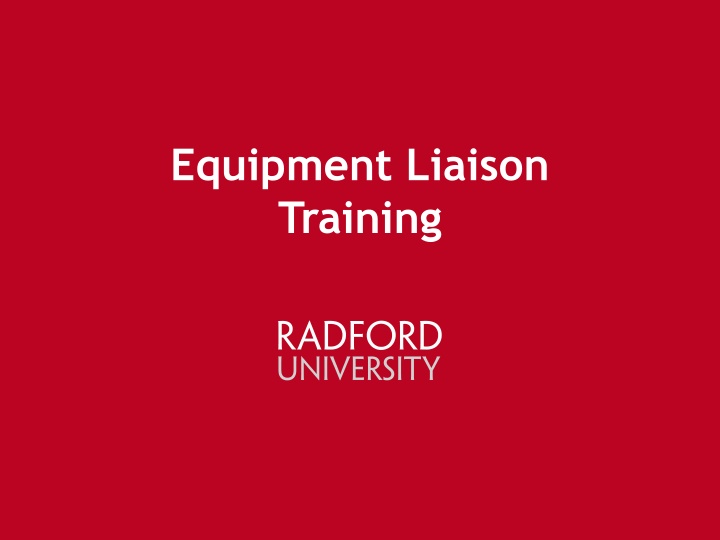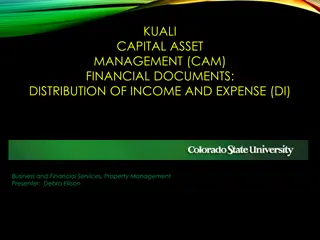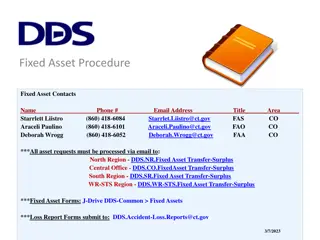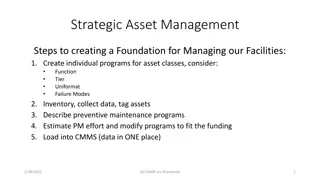University Asset Management Guidelines
University asset management guidelines cover the physical inventory policy, procedures, and fixed asset terminology for safeguarding, tracking, and reporting assets. Departments designate equipment liaisons to manage assets and conduct physical inventories regularly. Assets are categorized as capitalized or controlled, with specific guidelines for Equipment Trust Fund (ETF) equipment. The process includes tagging assets, conducting physical inventories, and assigning status codes. Custodians oversee safeguarding of assigned assets.
Download Presentation

Please find below an Image/Link to download the presentation.
The content on the website is provided AS IS for your information and personal use only. It may not be sold, licensed, or shared on other websites without obtaining consent from the author.If you encounter any issues during the download, it is possible that the publisher has removed the file from their server.
You are allowed to download the files provided on this website for personal or commercial use, subject to the condition that they are used lawfully. All files are the property of their respective owners.
The content on the website is provided AS IS for your information and personal use only. It may not be sold, licensed, or shared on other websites without obtaining consent from the author.
E N D
Presentation Transcript
Equipment Liaison Training
Physical Inventory Policy and Procedures The Physical Inventory Policy provides guidance on the physical inventory process for safeguarding, maintaining, tracking, and reporting of University assets. The policy is applicable to any division or department in possession of University assets that are capitalized or controlled. A physical inventory of tagged assets is required at least once every two years. Office of Financial Reporting
Physical Inventory Policy and Procedures Procedures related to the Physical Inventory Policy are found in the Equipment Liaison Handbook. Department Equipment Liaisons are instrumental in maintaining control of assets. Equipment Liaison: Designated by each department Manage department assets Monitor all asset activity Point of contact for asset status changes Office of Financial Reporting
Fixed Asset Terminology Asset: Any equipment item, personal or real property, whether tangible or intangible, owned by or in the possession of the University. Capitalized Assets: Assets with an expected useful life of greater than one year and with a value or cost of $5,000 or more on the date of acquisition. Controlled Assets: Equipment Trust funded or certain other assets costing less than $5,000. Equipment Trust Fund (ETF): A state program that provides additional funding for institutions to purchase equipment for instructional use. Additional important guidelines apply to the acquisition, maintenance, and disposal of ETF equipment (See Equipment Liaison handbook). Office of Financial Reporting
Fixed Asset Terminology Tagged Asset: Asset that meets university criteria for tracking purposes, either capitalized or controlled. Assigned a unique identifier. Asset tags are placed upon delivery to the warehouse. Physical Inventory: Process of physical identification of each tagged asset. A physical inventory of tagged assets is required at least once every two years. Status Code: Assigned to tagged assets in the Banner Fixed Assets system based on the results of the physical inventory. Custodian: An employee with vested responsibility to safeguard assets that are assigned to them. Office of Financial Reporting
Physical Inventories The CAPP manual requires a physical inventory of tagged assets at least once every two years. Status Codes: (A): Active Asset that can be verified and is currently in use by the University (S): Surplus Asset no longer in use by the University. However the asset remains in the possession of the University and has been properly transferred to Surplus Property. (D): Disposed asset is no longer in the possession of the University (M): Missing asset could not be physically located Office of Financial Reporting
Responsibilities Overview Office of Financial Reporting (Fixed Assets Section) Responsible for ensuring timely and accurate data is maintained in the University's official fixed asset system. Strives to ensure the University s assets are properly acquired, safeguarded, controlled, recorded, and disposed. Equipment Liaisons Safeguard, manage and monitor their department s assets. Dean, Director, Department Head involvement is critical to ensure oversight and attention is given to properly procuring, safeguarding, maintaining, and tracking University assets. Office of Financial Reporting
Financial Reporting Responsibilities Ensure Equipment Liaisons are assigned to each department. Ensure capitalized and controlled assets are properly tagged. Process disposal requests and missing asset listings for all departments. Coordinate conducting physical inventories with Equipment Liaisons. Carefully walk through all department locations to locate assets during physical inventory. Process forms that support asset status changes (disposals for trade-ins, surplus, custodian changes). Perform follow up inventory visits as requested. Office of Financial Reporting
Financial Reporting Responsibilities Communicate via memos, as applicable, to follow up on missing assets and conclude physical inventory process. Memos include: Request for Response on Missing Assets Resolutions (response required within 3 weeks) Results of Physical Inventory (must be signed and returned within 3 weeks) Annual Notification of Missing Assets If Financial Reporting determines a department has failed to properly safeguard assets, the applicable Division Head will be notified and more frequent physical inventories will be required. Office of Financial Reporting
Equipment Liaison Responsibilities Promptly report status changes. This includes acquisitions, transfer between departments, warranty replacements, disposition, cannibalization, destruction, loss, theft. Contact Financial Reporting if capitalized or controlled assets arrive in the department without being tagged. Transfer assets timely using the Department Equipment Change Form. The receiving department must complete this form. Notify Financial Reporting when receiving donated assets valued at $5,000 or more. Office of Financial Reporting
Equipment Liaison Responsibilities Ensure assets are acquired through proper procurement procedures Account codes ending with C are used for the following purchases: All ETF purchases All desktop, mobile, and mainframe computers and network servers Grant funded assets required to be inventoried and tracked All asset purchases of $5,000 or more Office of Financial Reporting
Equipment Liaisons Responsibilities Submit the Surplus Form, PU19,when a tagged asset is no longer needed or it is no longer in working order and cannot be repaired or improved in a cost-effective manner. All University property, including tagged assets but excluding ETF equipment, is eligible for transfer to Surplus Property. ETF equipment is eligible for surplus only after ownership passes to the University at the end of 3 years. If ETF equipment is lost or stolen before three years, ETF equipment must be replaced using departmental funds. Office of Financial Reporting
Equipment Liaison Responsibilities If applicable, gain an understanding of allowable status changes for grant funded assets to ensure compliance with the grant requirements. Office of Financial Reporting
Surplus Property Management Policy Surplus Property Management policy establishes the requirements and procedures for surplus property, including sale, transfer, disposal, and/or recycling of such property. This policy is applicable to all University divisions, departments, offices, and employees and all University property meeting the definition of surplus property regardless of the funding source. Surplus property is managed by Surplus Operations within Facilities and Maintenance. Disposal of grant funded equipment must comply with the requirements of the grant. Office of Financial Reporting
Inventory Best Practices Review inventory listing in advance of inventory Notify faculty of inventory dates Comply with deadlines and respond promptly Accompany Financial Reporting staff Ensure assets are available and tags are visible Ensure laptops and iPads are on campus on the date of inventory. Office of Financial Reporting
Inventory Best Practices Supporting paperwork readily available Provide written response to the missing asset listing in a timely manner Office of Financial Reporting
Tracking Non-Tagged Assets Identify asset purchases that are critical to the mission of your department, used by students, or susceptible to theft. Record asset details as soon as the equipment arrives. Develop safeguarding and monitoring procedures. Conduct yearly departmental inventories to determine location and condition of the asset. Remind department members of the best practices for handling all University asset purchases. Contact Financial Reporting for guidance. Office of Financial Reporting
Questions? Contact the Office of Financial Reporting Mike Long Fixed Assets Senior Accountant Email: mlong18@radford.edu Phone: (540) 831-5592 Inventory or miscellaneous inquiries Sandy Reed Fixed Assets Technician Email: sreed31@radford.edu Phone: (540) 831-7611 Tagging inquiries Office of Financial Reporting
Resources Office of Policy and Compliance website University wide Policies and Procedures Financial Reporting website Departmental Change Form Department Equipment Liaison Assignment Form Facilities Management website Surplus Form PU19 Office of Financial Reporting
Quiz Questions 1.) What is the role of an Equipment Liaison? A. Instrumental in maintaining control of his/her assigned department s assets B. Assist the University with appropriate stewardship of assigned equipment C. Assist the University with appropriate accountability for assigned equipment D. All of the Above 2.) Which are important Equipment Liaison Responsibilities? A. Ensure assets are acquired through proper procurement procedures and correctly coded. Refer to the updated Expenditure Account Code Listing B. Contact Financial Reporting if capitalized or controlled assets arrive in the department without being tagged C. Contact Financial Reporting when receiving donated equipment valued at $5,000 or more from the Radford University Foundation D. Notify Financial Reporting of disposed assets (trade-ins, loss, theft, cannibalization, return to vendor) E. All of the above 3.) Which is not a best practice in preparing for an Inventory? A. Set up inventory date for a time that the majority of your department is on campus B. Follow up with faculty to ensure laptops and iPads are on campus on the date of inventory C. Do not notify faculty of inventory dates D. Ensure assets are available and tags are visible E. Have supporting paperwork for status changes readily available Office of Financial Reporting
Thank you for completing the Radford University Equipment Liaison Training Office of Financial Reporting























